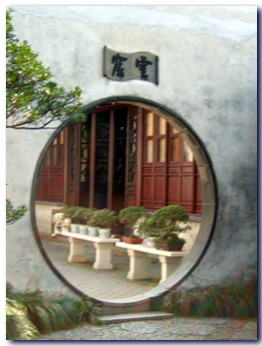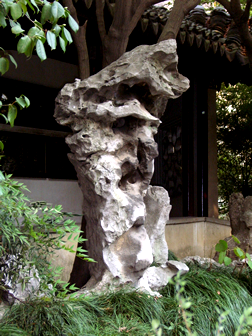Issue 19
Chinese Gardens Explained
 Have you ever wondered what a Chinese garden is all about? Then maybe the following article may go some way to unravelling the mystery for you.
Have you ever wondered what a Chinese garden is all about? Then maybe the following article may go some way to unravelling the mystery for you.
In China, gardens are considered a serious art form along with painting, sculpture and poetry. Designers adhere to the Taoist principles of harmony and balance, man and nature, using natural elements such as water, rock, plants and artificial elements such as architecture, painting and poetry.
Water is the central component of a Chinese garden, the gardens living pulse. The jade colour of the water is created by clay on the bottom of the ponds, and symbolises tranquillity. It also provides an environment for water plants and goldfish, which are regarded as symbols of good fortune. Water is also used as a mirror giving the appearance of a bigger garden. It also helps to regulate humidity and helps purify and cools the air around it. Rocks are often porous and large in size, the best coming from Lake Taihu near Suzhou. These water-worn limestone rocks which are placed throughout the garden are one of the unique features in a Chinese garden. The Taihu rocks are thought to evoke supernatural powers and entice lucky spirits in a garden. As the day progresses, the light changes and infinite colours and textures appear on these chameleon like rocks. The stones appear to take on shapes. Can you see a bear in the one pictured?
Rocks are often porous and large in size, the best coming from Lake Taihu near Suzhou. These water-worn limestone rocks which are placed throughout the garden are one of the unique features in a Chinese garden. The Taihu rocks are thought to evoke supernatural powers and entice lucky spirits in a garden. As the day progresses, the light changes and infinite colours and textures appear on these chameleon like rocks. The stones appear to take on shapes. Can you see a bear in the one pictured?
Plants in the garden are selected as much for their symbolic meaning as for their colour and appearance. The lotus is purity, as it flowers from the mud; bamboo is resolve, as it difficult to break; plum is vigour, as it blooms in winter; the pine is longevity, as is an evergreen; the imperial peony is wealth.
The buildings in the garden are designed to accent the garden, with windows and doorways that frame scenic views in the courtyards and beyond. Pavilions, corridors, verandas provide shelter so garden viewing can take place in any weather. Corridors often have windows or "scenic openings", which act as picture frames, for example, squares or ovals, or more imaginative shapes like a lotus petal or bay leaf. A moon gate is a door that neatly frames a view as though it were a picture. Gates can also be square, jar or even book-shaped.
path
 Paths curve, making the viewer move slowly and inviting them, by this slow pace, to enjoy small views or landscape compositions throughout the garden. Coloured pebbles form patterns mosaics on the paths with such designs as a bat or a crane, symbolising good fortune and longevity. Often poetry is carved in stone. People are encouraged to walk barefoot along the paths, as the raised surfaces serve as a natural reflexology treatment.
Paths curve, making the viewer move slowly and inviting them, by this slow pace, to enjoy small views or landscape compositions throughout the garden. Coloured pebbles form patterns mosaics on the paths with such designs as a bat or a crane, symbolising good fortune and longevity. Often poetry is carved in stone. People are encouraged to walk barefoot along the paths, as the raised surfaces serve as a natural reflexology treatment.
I hope that this article goes some way to explaining what a Chinese garden is all about, of course it only touches on the subject and a lot more space would be needed to fully explain it all. The pictures in this article were photos that I took on my recent holiday in China and were taken in the "Garden" city of Suzhou in Jiangsu Province, Central China. The garden was called "The Master of the Nets" garden and was one of the many Highlights of my holiday of a lifetime. Maybe you too will one day enjoy the experience of a real Chinese garden.
RonH





